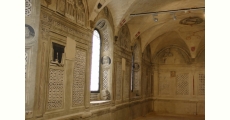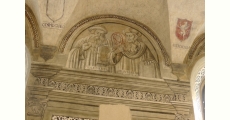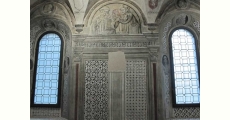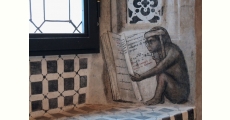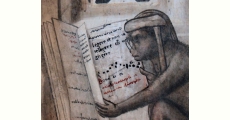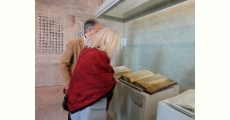Siete qui:
- Home
- The MODO Museum
- The Museums Venues
- Papal Palaces – The Rooms
- The Albèri Library. Additional information
The Albèri Library. Additional information
The Albèri Library gives us an insight into what was going on in the fifteenth-century Cathedral workshop in the Renaissance, with the great artists of the time at work in the Cathedral: Gentile da Fabriano, Piermatteo d'Amelia, Antonio da Viterbo, Pinturicchio and, on the scaffolding of the Cappella Nova, Fra Angelico and Luca Signorelli. This fascinating room, set between the cathedral and the Papal Palaces, was built in 1499 for the library of the archdeacon Antonio Albèri (ca. 1423 – 1505), who in his will (1482) bequeathed his collection of over 300 volumes, consisting of manuscripts and precious incunabula, to the cathedral.
After receiving his doctorate in utroque iure in the Studium of Perugia, he was introduced into the cultural circle of Pope Pius II and his nephew Francesco Todeschini Piccolomini, as the latter's preceptor and secretary. When in 1503 Todeschini Piccolomini became pope as Pius III, he nominated Albèri bishop of Sutri and Nepi.
It was on the example of the Piccolomini Library, created within the Sienese cathedral (1492-1507), that Albèri had new premises built for his library. It was decorated between 1501 and 1503, the years in which Luca Signorelli was at work in the Cappella Nova. The fresco cycle (in the library) was dedicated to the authors of the principal disciplines of study and was closely connected to the Judgment frescoes, both in the theme of the studia humanitatis, and in its stylistic similarities with Signorelli, perhaps executed by close collaborators.
The decorative scheme is as follows:
on the west wall
I and II lunette – THEOLOGY – represented by St. Augustine, St. Gregory the Great, St. Jerome and St. Ambrose;
on the south wall
I lunette – IUS CANONICUM – represented by two unidentifiable figures;
I window embrasure – IUS CANONICUM – with Pius II, St. Bonaventura and St. Thomas Aquinas;
II lunette – IUS CANONICUM/PHILOSOFIA – with D. Benedictus Capra and M. So[...]nus;
II window embrasure – IUS CIVILE – with Ulpian, Bartolo da Sassoferrato and Baldo degli Ubaldi;
III lunette – MEDICINE – with Hippocrates and Gallienus;
III window embrasure– HISTORICI – with Quintus Curtius, Giovanni Antonio Campano and Sallust;
IV lunette – ASTROLOGERS – with Albumasar and Ptolemy;
IV window – ORATORS – with Cicero, Quintilian and Pliny;
V lunette – POETRY – with Juvenal and Ovid;
on the east wall
VI lunette – POETRY – with Virgil and Homer;
VII lunette – GRAMMAR – with Sipontinus and Priscianus.
The names of the disciplines and the emblems (coats of arms?) of some of the cities connected to the patron - Perugia, Rome, Siena and Todi – are between the lunettes. Below, three small polychrome pictures depict St. Peter, St. Paul and Seneca. Two medallions with the monogram of St. Bernardino and the Albèri coat of arms decorate the spacious vault.
The curious image in an embrasure of a monkey wearing eyeglasses reading an open book with the spirited motto LEGERE ET NON INTELLIGERE EST NEGLIGERE / BONA DIES (to read without intelligence is negligence as Cato declares belongs in the repertory of ars illuminandi.
The Albèri Library collection was unfortunately scattered in the course of the centuries and subsequently the room was used as a private chapel and sacristy by the bishops. The walls were whitewashed and the painted decoration was not rediscovered until 1890 when restorations were carried out in the cathedral.
Recent restoration by the Soprintendenza BSAE of Umbria has returned this unique room including the pictorial decoration to its original condition. With the exception of the Piccolomini Library, it is probably the only other library annexed to a cathedral church known.



